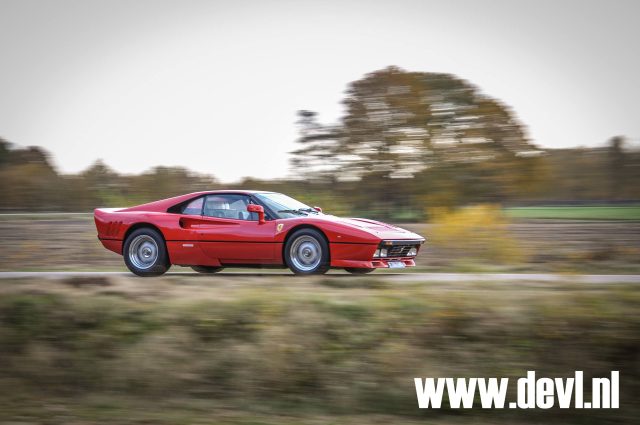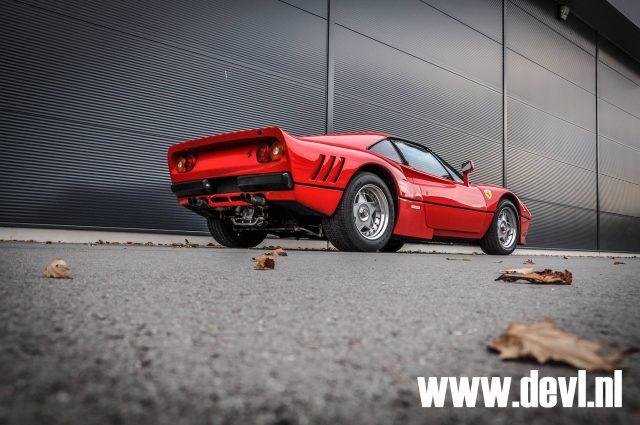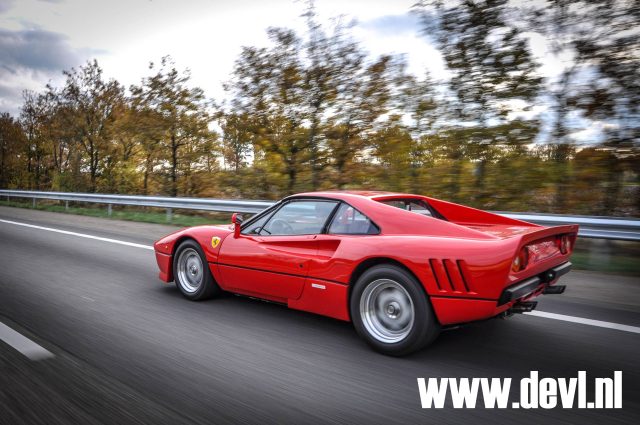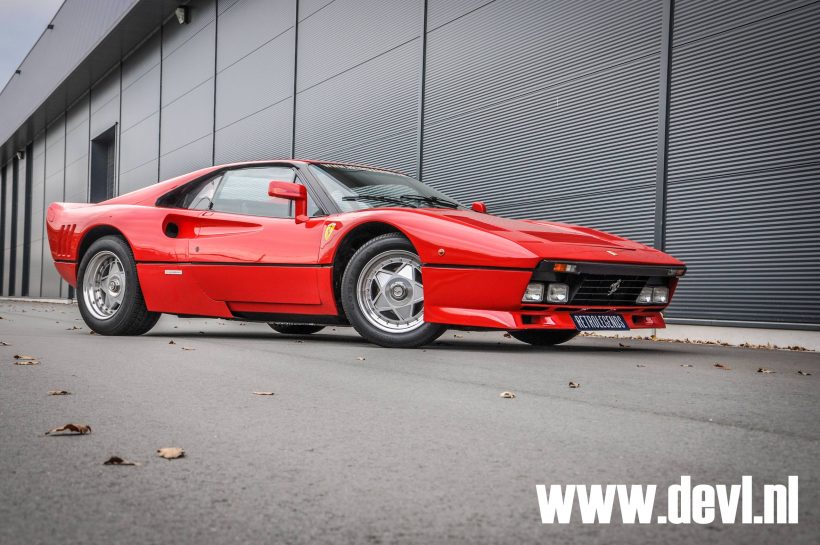Jim Carpenter, a Ferrari specialist from Phoenix, Arizona, put himself on the radar in the 1980’s with the way he converted Ferraris 308 and 328 to a 288 GTO. That “Grand Turismo Omologata” assumed the mantle of a legend the second it was introduced in 1984. All 272 examples were not only formidably expensive, they were sold out as quickly as they drove. “We love Ferrari’s. We have original Ferrari’s just as well, but some models are simply out of reach for us mere mortals. That fact gives the cars I build a right to exist. I respect Ferrari and their product as much as the next aficionado”, Carpenter says. But hey, if your neighbour can make a realistic copy of the Mona Lisa, that doesn’t make him Da Vinci, does it?
Like all Ferrari’s, the 288 GTO seduces on many fronts. Cosmetically first, of course. In the seventies Pininfarina drew up the Ferrari 308, which became famous with Tom Selleck’s Magnum-moustache behind the wheel. Despite that the 308 was a wonderfully proportioned Italian thouroughbred, which was also true for its successor, the 328. Its sharp nose, the subtle flanks and the big behind with those subtle, double round tail lights: it is all just right. Ferrari’s choice to make the 328 the basis fort he GTO was therefore a good one. Still, design chief Leonardo Fioravanti of Pininfarina, managed to give the GTO its own face. Visually it has a lot in common with other Ferrari’s, but small changes did the trick to make clear that the GTO was indeed something speical. Whether that was the impressive front with its double headlights, the lower roofline, the bigger wheels or the subtle gills – a direct reference tot he legendary 250 GTO – in the rear panel, everyone can decide for themselves. Fact is that since its introduction, the GTO is considered as one of the most beautiful, if not the most beautiful car ever. Artists, the folks at Pininfarina.

Technically the GTO was a piece of art too. Its occupants were protected by a rollcage that was ingeniously incorporated into the roof and B-pillars. In the F1-races of the 1980’s Ferrari had already proven to know its way around turbo power. Decided was to bolt two of those onto the GTO’s V8, which brought a rather spectacular result: 400 horsepower and 495 Nm of torque. That might not sound too spectacular, but the GTO only weighed 1160 kilo’s. A power-to-weight ratio of that magnitude was unheard of and in a way it still is. The GTO was breathtakingly fast. Ferrari promised it would get to 60 in 4.8 seconds, and would go on to a top speed of 187 miles per hour. Despite all that the GTO – its rarity aside – has one major problem. The price. If you manage to find one for sale, a good example will cost you around six tonnes. At least.
The Ferrari 328 in the pictures was sent to Jim Carpenters workshop in the USA. With lots of love and patience Carpenter developed a bodykit that could turn both “juniors” into GTO’s, and that only the real connaisseur could distinguish from the real thing. Many clients opted fort he cosmetic transformation alone, but a complete technical overhaul was also possible. Carpenter didn’t settle for less than the real thing, he only used original Ferrari parts. The engine of the donor car was removed, and new engine mounts were put in place. Those were needed to put the engine back in the car lower and longitudinally, as to improve the center of gravity. After that the injection system was remapped, and two turbo’s and intercoolers were added. After that, powers figures of the real GTO could easily be reached and even surpassed. All that extra power meant that the rest of the car needed some added fitness too: a stronger clutch, better brakes and improved suspension were added by Carpenter to harness all that power. All this beauty required some small offers from Carpenters cliets. On average, the conversion of a cart ook around about a year. And the price? That neared 150.000 dollars, but fort hat money you had to provide the donor car yourself. And that didn’t come cheap either.

The car we drove underwent the full treatment. Certain is that this Ferrari was delivered to its first owner in Gemany in 1986 as a 328 GTS. Soon after that – when is not known – it took on the journey tot he USA where Jim Carpenter set to work on it. After that the car ended up with a Dutch collecter, who later sold it to Henny Kennis, trader in exclusive cars. “This car was probably meant to go racing”, Kennis says, “but as far as I can figure out it never actually raced.” Judging by the low mileage it didn’t drive much at all, but that doesn’t mean it can’t. The GTO – excuse us, 328 – reacts vividly and eagerly to your commands. And if you think the V8 is already spectacular at low revs, you won’t know what hit you when the needle of the rev counter passes 4000. Then the engine really starts to shout. Like it is threatening the road in the most colorful Italian language.
Back to Carpenter. “Before I sold my company I made 49 GTO-conversions in total. Only 9 of those had a longitudinal engine installed, and three of those nine had a 348-engine. That means only six of these actual cars were made. I’m proud of it, it definitely stood the test of time.” As rare as his conversions may be, Carpenter made the Ferrari GTO a little bit less rare, and who can’t afford a real GTO or simply likes to see one “in the wild” can only applaud that. Fake, okay, but this care is something different completely to a Golf with a big exhaust and huge wheels. Cost nor effort was spared tot reproduce a costly piece of art. That doesn’t make it the real thing, but it does come painfully close to the original. “Great!” like every American would say. We though, prefer the Italian translation: Grande.

The feature about Jim Carpenters GTO-conversion was published in AutoWeek in 2015.
